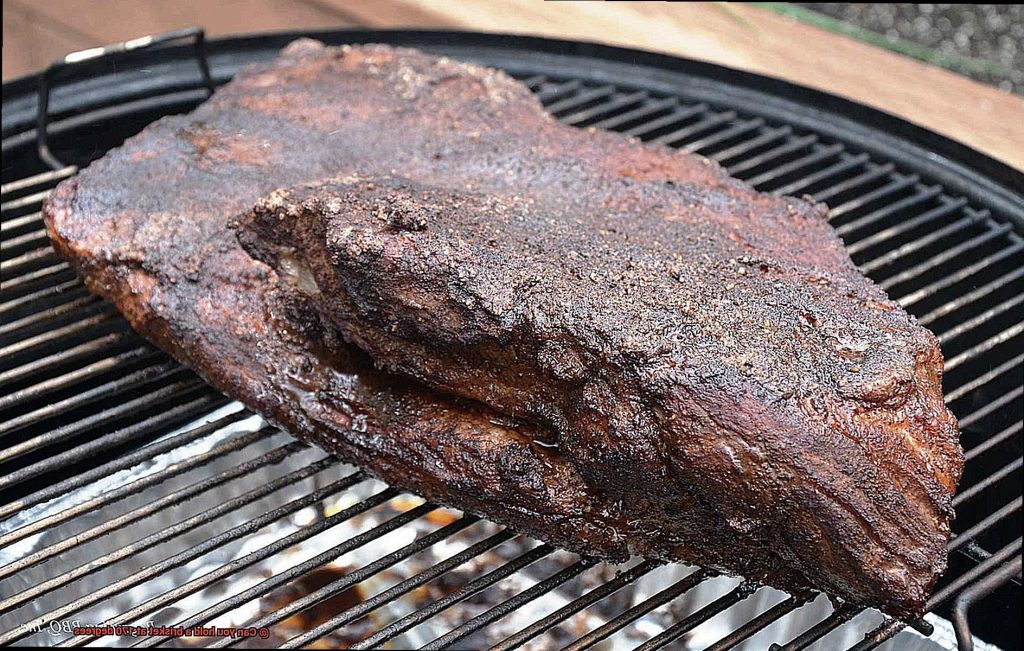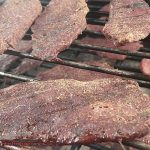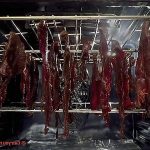Imagine this: you’ve painstakingly chosen the juiciest brisket, marinated it with an irresistible blend of spices, and tenderized it to perfection. Your taste buds tingle in anticipation of that mouthwatering slice of meat, but life throws a curveball, and you can’t devour your creation just yet.
Don’t fret, my fellow food enthusiasts. The burning question on every brisket lover’s mind is whether you can hold a brisket at 170 degrees. Today, we’re here to provide the answers. In this blog post, we’ll uncover the secrets behind holding a brisket at 170 degrees – the dos and don’ts, strategies, and tips that will ensure your culinary masterpiece remains succulent and flavorful even after hours of delay.
Are you ready to become a brisket maestro, impressing friends and family with your culinary wizardry? Let’s dive right in. But first, let’s understand why maintaining a consistent temperature is crucial and why 170 degrees holds the key to brisket perfection.
Contents
What is a Brisket?
In this comprehensive guide, we will delve into the world of brisket, exploring its composition, cooking methods, flavor profiles, and even debunking the myth surrounding holding temperatures. Get ready to embark on a culinary adventure that will elevate your grilling game.
Unveiling the Brisket:
- Hailing from the breast or lower chest region of a cow, the brisket is a substantial cut of meat.
- It boasts interwoven layers of fat and connective tissue, adding depth and richness to its flavor profile.
- When cooked correctly, brisket delivers unparalleled tenderness and an explosion of flavors.
Decoding Different Cuts:
- The Point (Deckle): This fatty and marbled section is ideal for creating irresistible burnt ends or making mouthwatering chopped brisket sandwiches.
- The Flat: Leaner and more uniform in shape, the flat cut is perfect for slicing and serving in all its glory.
Conquering Cooking Challenges:
- Brisket’s resilient nature necessitates long, slow cooking techniques to soften its texture.
- Collagen breakdown and fat rendering are essential steps in achieving that coveted tender and flavorful result.
Seasoning Sensations:
- Elevate the natural flavors of brisket with dry rubs or marinades that tantalize the taste buds.
- Classic seasoning favorites include salt, pepper, garlic powder, paprika, and a medley of aromatic spices.
- Keep the meat moist by employing mop sauces or bastes during the smoking or grilling process.
Temperature Triumphs:
- Optimal cooking temperature range: 225 to 250 degrees Fahrenheit.
- To achieve perfectly cooked brisket, aim for an internal temperature of approximately 195 to 205 degrees Fahrenheit.
Can You Hold a Brisket at 170 Degrees?
- Proceed with caution when considering holding a brisket at 170 degrees.
- First, ensure that the brisket reaches the desired internal temperature of 200 to 205 degrees Fahrenheit.
- Wrap it tightly in aluminum foil or butcher paper, then place it in a preheated cooler or insulated container.
- Monitor the temperature regularly to maintain a safe range above 140 degrees Fahrenheit.
- Avoid holding for more than two hours to prevent overcooking and drying out the meat.
Typical Temperature Range for Cooking a Brisket
Put on your aprons and prepare to embark on a journey into the realm of brisket. Ah, brisket, the crowned king of barbecues. This cut of meat may seem daunting to cook, but fear not, my friends, for I am here to guide you through it.
When it comes to cooking a brisket, temperature is everything. We’re talking about a slow and steady process here, folks. The magic happens within the temperature range of 225 to 250 degrees Fahrenheit. But why, you ask? Let me break it down for you.
Brisket is like a culinary Houdini – it requires time and heat to work its wonders. The low temperature allows the connective tissues in the meat to break down slowly, resulting in a tender and juicy masterpiece. It’s like transforming a tough guy into a gentle giant with just a little patience.
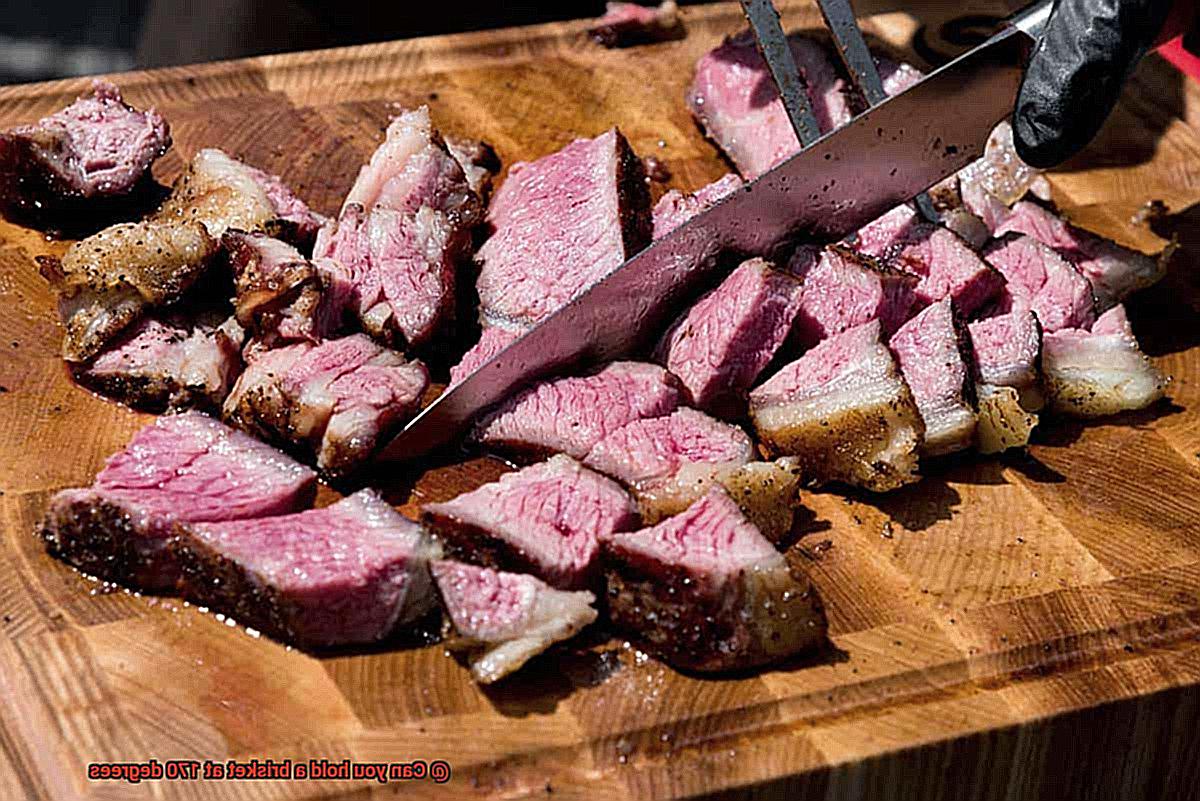
But that’s not all. Cooking within this temperature range ensures that your brisket cooks evenly from edge to edge. No more worries about dry patches or tough bites. Just pure brisket perfection.
Now, remember to keep an eye on the internal temperature of your brisket as it cooks. Grab yourself a reliable meat thermometer and aim for an internal temperature of around 195 to 205 degrees Fahrenheit. That’s when the real magic happens. The collagen has broken down, the fat has rendered, and you’re left with a melt-in-your-mouth delight.
Slow and steady wins the race, my friends. Whether you’re using a smoker or an oven, make sure you cook your brisket with indirect heat to maintain a consistent temperature throughout the process.
Once your brisket reaches its desired doneness, resist the temptation to slice it up immediately. Let it rest for at least 30 minutes. This allows the juices to redistribute throughout the meat, ensuring every bite bursts with flavor.
Benefits of Holding a Brisket at 170 Degrees
Imagine sinking your teeth into a tender and juicy masterpiece that melts in your mouth with every bite. How do you achieve such perfection, you ask? Allow me to introduce you to the myriad benefits of holding a brisket at 170 degrees.
Tender Texture:
Cooking a brisket at a low and slow temperature of 170 degrees is the secret to achieving a delightfully tender texture. By allowing the tough collagen in the meat to break down gradually, you bid farewell to chewy bites and welcome melt-in-your-mouth goodness.
Perfect Internal Temperature:
Holding your brisket at 170 degrees ensures it reaches the ideal internal temperature for serving, around 200-205 degrees Fahrenheit. This magical range guarantees that connective tissues dissolve completely, leaving you with a brisket that practically falls apart at the touch.
Flavorful Fusion:
Patience is rewarded when it comes to flavors. Slow cooking at 170 degrees allows spices and seasonings to infuse deeply into every fiber of the meat, resulting in a symphony of rich and savory flavors that will have your taste buds dancing with delight.
Easier Carving and Slicing:
Holding your brisket at 170 degrees means the meat will be more tender and hold its shape better. This makes carving and slicing a breeze, enabling you to achieve clean and even slices that will impress even the most discerning barbecue connoisseur.
Timing and Convenience:
Planning a large gathering or special occasion? Holding your brisket at 170 degrees offers the convenience of having the meat ready and waiting without overcooking or drying out. It’s like having a trusty assistant in the kitchen, ensuring your meal is perfectly timed and effortlessly delicious.
Flexible Serving Times:
Life happens, plans change, and guests might arrive fashionably late. Fear not. Holding your brisket at 170 degrees ensures it remains tender and delicious even if you need to delay serving. It’s a culinary safety net that guarantees your masterpiece will be enjoyed at its best, regardless of timing.
Bark Perfection:
We can’t forget about the coveted bark on the outside of the brisket. Cooking at a low temperature for an extended period allows the sugars in the rub to caramelize beautifully, creating a flavorful crust that will make your barbecue the talk of the town. The result is a perfect balance of succulent meat and smoky, caramelized goodness.
Considerations When Holding a Brisket at 170 Degrees
Brisket, the crown jewel of barbecued meats, demands finesse to unlock its legendary tenderness and flavor. Among the many techniques that intrigue grill masters is the art of holding a brisket at 170 degrees. While it is possible to do so, it is crucial to understand the considerations involved to avoid potential pitfalls and ensure a mouthwatering result that tantalizes taste buds.
The Pitfalls of Overcooking:
The cardinal sin of brisket is overcooking. Holding it at 170 degrees for an extended period risks transforming tender meat into a dry and unappetizing texture. To achieve the sought-after melt-in-your-mouth tenderness, low and slow cooking is essential for breaking down connective tissues.
Prioritize Food Safety:
Although 170 degrees exceeds the USDA’s minimum internal temperature recommendation for beef (145 degrees), it is important to note that this may not guarantee food safety over an extended period. Bacteria thrive in temperatures between 40 and 140 degrees, known as the “danger zone.” To ensure food safety, cook your brisket to the recommended temperature and serve immediately or store it properly to avoid potential health risks.
Preserving Flavor Intensity:
The succulent flavor of brisket is one of its greatest delights. Holding it at 170 degrees for too long can cause moisture loss, resulting in a less juicy and flavorful end product. To preserve those delightful flavors, choose a cooking method that allows for proper resting after reaching the target temperature.
The Texas Crutch Method:
If you need to hold your brisket before serving, consider employing the “Texas crutch” method. By wrapping your perfectly cooked brisket tightly in foil or butcher paper and placing it in a cooler, you can retain moisture and heat. This technique enables the brisket to continue cooking gently while being held at a safe temperature, ensuring optimal tenderness and flavor.
The “Texas Crutch” Method for Holding a Brisket at 170 Degrees
The “Texas Crutch” method is a popular technique used by pitmasters in Texas to hold a brisket at a consistent temperature of 170 degrees Fahrenheit. This method ensures that the brisket remains tender, juicy, and full of flavor until it’s time to serve.
To execute the Texas Crutch, pitmasters wrap the brisket tightly in either foil or butcher paper. This wrapping creates a seal that retains moisture and helps to maintain a steady temperature. The name “Texas Crutch” is derived from the concept of using this wrapping technique as a crutch to support the meat during the holding process.
Here’s a step-by-step guide on how to use the Texas Crutch method:
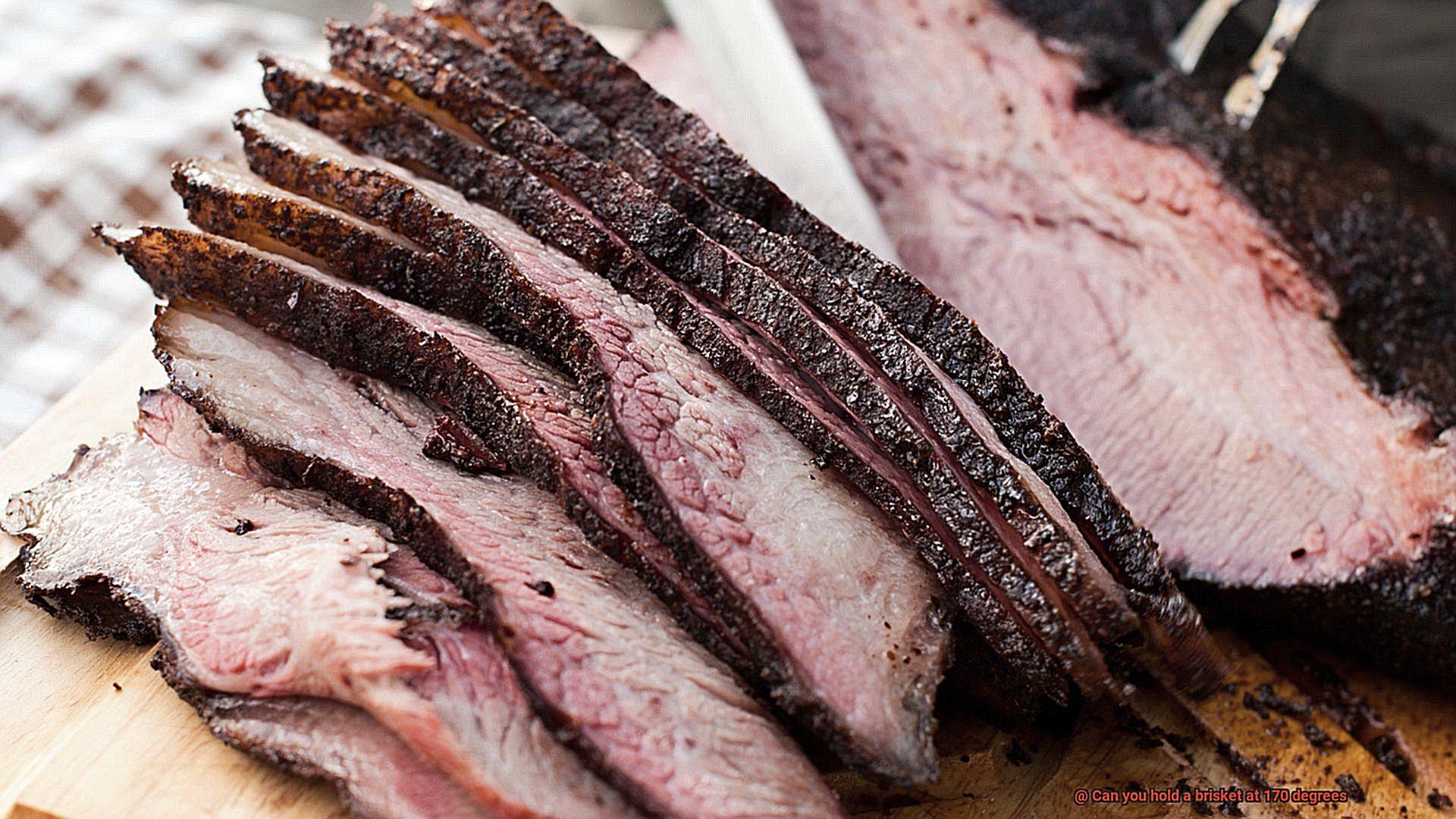
Start by smoking your brisket until it reaches your desired level of tenderness. This can take anywhere from 8 to 12 hours, depending on the size of your brisket and the temperature of your smoker. The low and slow smoking process allows the meat to absorb the smoky flavors and develop its characteristic bark.
Once your brisket has reached the desired tenderness, it’s time to crutch it. Wrap the brisket tightly in either foil or butcher paper, ensuring that there are no gaps or openings that could allow moisture to escape.
If you want to enhance the flavor of your brisket, you can add some beef broth or apple juice into the foil or butcher paper before sealing it up. This additional liquid will infuse the meat with even more deliciousness as it continues to cook.
With your brisket crutched, you can now hold it at 170 degrees Fahrenheit. There are two main methods for doing this. You can either place the wrapped brisket back into your smoker, adjusting the temperature as needed to maintain a steady heat, or you can transfer it to a cooler lined with towels for insulation.
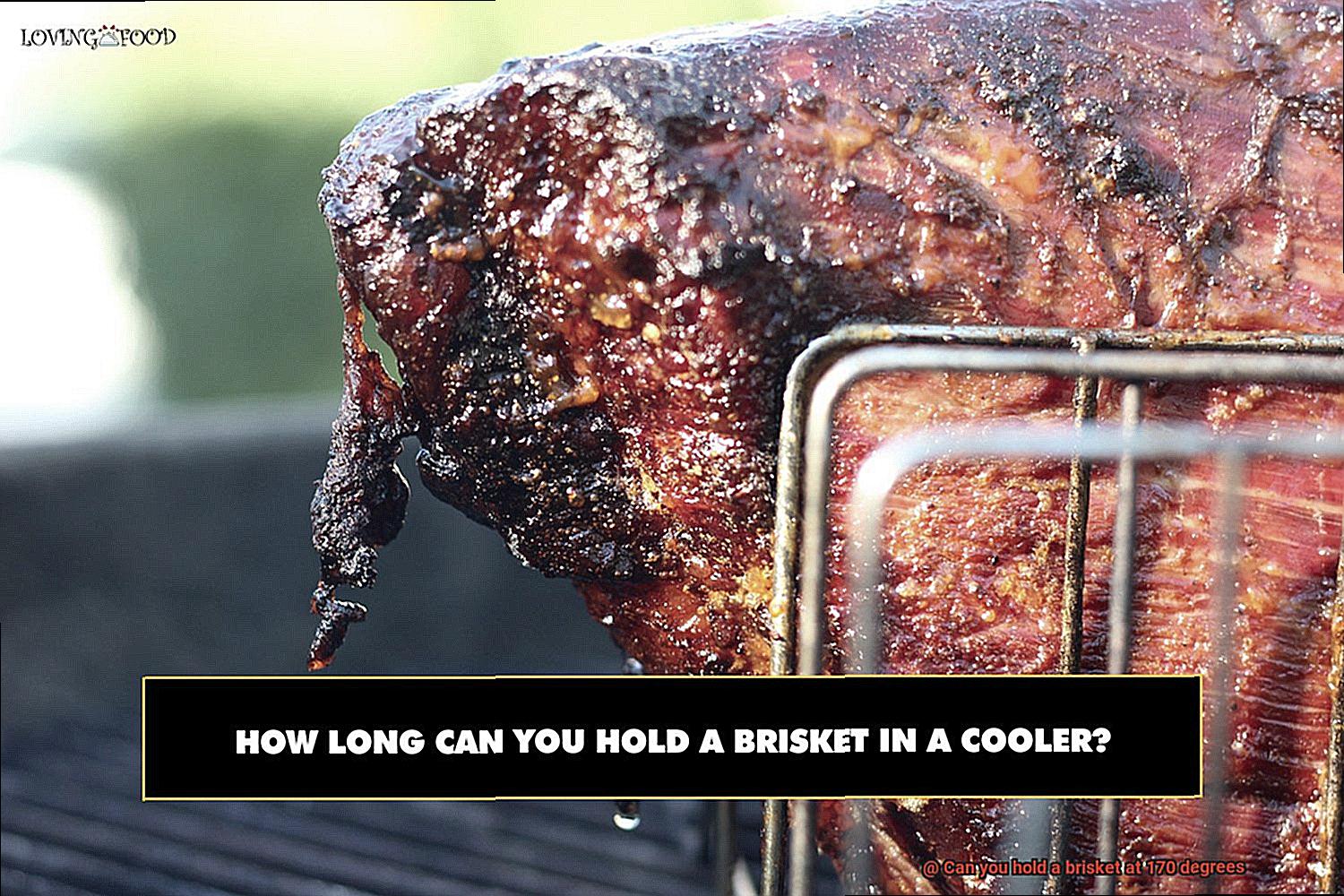
It’s crucial to monitor the internal temperature of your brisket using a meat thermometer. This ensures that it stays within the desired range and avoids overcooking or drying out the meat.
The length of time you can hold your brisket at 170 degrees will depend on various factors, including the initial cooking time and the size of your brisket. However, it is generally recommended not to hold it for longer than two hours to preserve its flavor and tenderness.
The Texas Crutch method is particularly useful for those who want to prepare their briskets in advance for events or gatherings. It allows you to have flexibility in serving times without sacrificing the quality of the meat. By following this technique, you can guarantee that your brisket will stay moist, tender, and full of flavor until everyone is ready to enjoy it.
Monitoring the Internal Temperature of the Brisket
Today, we embark on a journey into the world of brisket, uncovering the secrets to monitoring its internal temperature. With my expertise as your guide, we will ensure that your brisket turns out tender, juicy, and absolutely mouthwatering. So grab your trusty meat thermometer and let’s dive in.
The Crucial Importance of Temperature Monitoring:
The path to the perfect brisket begins with accurately monitoring its internal temperature. This not only guarantees that it reaches the desired level of doneness but also ensures its tenderness throughout. Let’s now explore the necessary tools for this precise task.
Choosing the Right Thermometer:
Investing in a reliable meat thermometer is paramount for monitoring your brisket’s internal temperature. Two main options present themselves: instant-read thermometers and probe thermometers. Instant-read thermometers are fantastic for quick readings, inserted into the thickest part of the brisket. Conversely, probe thermometers can be left inside throughout cooking, allowing for continuous monitoring.
Getting an Accurate Reading:
Using a meat thermometer correctly entails inserting it into the thickest part of your brisket, avoiding any contact with bones or fat. This ensures an accurate reading of the meat’s internal temperature.
At around 170 degrees Fahrenheit, your brisket might enter what we call the “stall” phase. But fear not. During this stage, temperatures may plateau or even decrease slightly as moisture evaporates from the meat’s surface. Here’s where patience is key—maintain a consistent temperature until your brisket reaches the recommended internal temperature range.
Embracing Customization with Cooking Times:
Remember, each brisket is unique, and cooking times may vary based on factors like size, thickness, and cooking method. Relying on internal temperature rather than a specific cooking time enables you to determine when your brisket is done to absolute perfection.
Calibration: The Key to Accuracy:
Before embarking on your brisket adventure, calibrate your meat thermometer to ensure precise readings. A simple step like placing it in ice water and adjusting it to read 32 degrees Fahrenheit can prevent any inaccuracies in temperature readings.
Resting Time: The Final Touch:
Once your brisket has reached the recommended internal temperature range (around 195-205 degrees Fahrenheit), it’s tempting to dig right in. But hold on. Allow your masterpiece to rest for at least 30 minutes before slicing. This crucial step allows the juices to redistribute throughout the meat, resulting in a more tender and flavorsome brisket.
Potential Risks of Holding a Brisket at 170 Degrees
Holding a brisket at 170 degrees may seem like a harmless idea, but it comes with potential risks that can jeopardize the quality and safety of your meal. Let’s delve into these risks in more detail:
- Dryness: Brisket is renowned for its melt-in-your-mouth tenderness and juiciness. However, holding it at 170 degrees for too long can cause the precious moisture to evaporate, leaving you with a dry and tough piece of meat. Say goodbye to that succulent brisket experience.
- Bacterial Growth: At 170 degrees, the brisket enters the danger zone (40 to 140 degrees), where bacterial growth thrives. To ensure your meal is safe to eat and minimize the risk of foodborne illnesses, it is recommended to cook the brisket to an internal temperature of at least 145 degrees.
- Overcooking: Brisket is a tough cut that requires low and slow cooking to break down collagen and achieve optimal tenderness. However, if you hold it at 170 degrees for an extended period, you risk overcooking the meat. The result? A loss of texture and flavor that will leave you disappointed.
- Loss of Smoke Flavor: Many grill enthusiasts relish the smoky taste infused into their brisket. Unfortunately, holding it at 170 degrees for too long can cause that delicious smoke flavor to dissipate, robbing your dish of its mouthwatering essence.
- Uneven Cooking: Achieving a perfect brisket requires consistent heat distribution to ensure every part cooks evenly. However, holding it at 170 degrees increases the likelihood of some areas becoming overcooked while others remain undercooked. The consequence? An inconsistent texture and taste that will leave your guests perplexed.
Recommended Time Limit for Holding a Brisket at 170 Degrees
We have all the answers you need. In this comprehensive guide, we will explore the recommended time limit for holding a brisket at 170 degrees, ensuring both food safety and delectable results.
The Science of Temperature Control
To truly understand the recommended time limit, it is crucial to delve into the science behind temperature control. Slow cooking a brisket at a low temperature allows the tough connective tissues to break down, resulting in an irresistibly tender and flavorful final product. However, once it reaches 170 degrees, caution must be exercised.
The Perils of the Danger Zone
The United States Department of Agriculture (USDA) states that perishable foods should not be kept within the “danger zone” temperature range of 40 to 140 degrees Fahrenheit for more than two hours. Within this range, bacteria thrive and multiply rapidly, transforming your mouthwatering brisket into a potential health hazard.
Factors to Consider
When slow smoking a brisket, it is likely that it has already spent a substantial amount of time at lower temperatures. This implies that you may have already taken into account the overall time spent in the danger zone. Furthermore, experienced pitmasters argue that holding a properly cooked brisket at 170 degrees for longer can actually enhance its tenderness and flavor.
Recommended Time Limit
While flexibility exists within this realm, caution should always prevail. It is generally recommended to limit the holding time to no more than four hours. Beyond this point, the risk of bacterial growth increases significantly, and the quality of the meat may begin to deteriorate.
Safety Tips for Brisket Perfection
To ensure both safety and succulence, monitor the internal temperature of the brisket using a reliable meat thermometer. Additionally, tightly wrapping it in foil or butcher paper will help retain moisture, preventing it from drying out during the holding process.
yWhnGfI1bds” >
Conclusion
In conclusion, it is not recommended to hold a brisket at a temperature of 170 degrees.
This low temperature can lead to the growth of harmful bacteria and compromise the safety of the meat. It’s crucial to ensure that the internal temperature of the brisket reaches at least 145 degrees Fahrenheit to kill any potential bacteria.
Additionally, holding a brisket at 170 degrees for an extended period can result in dry and overcooked meat, diminishing its flavor and tenderness.

